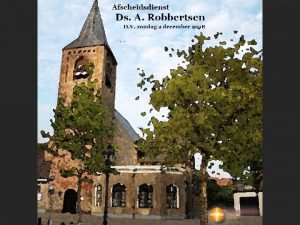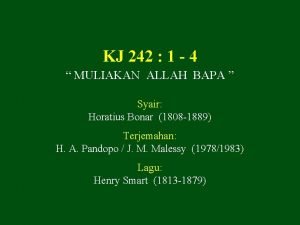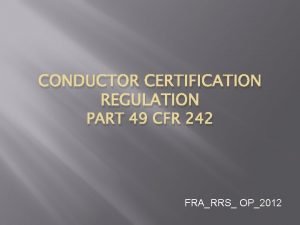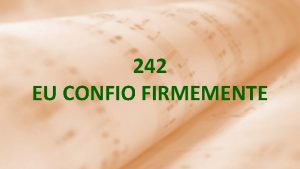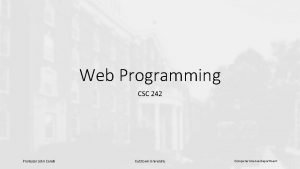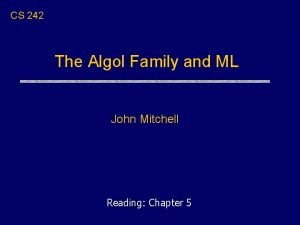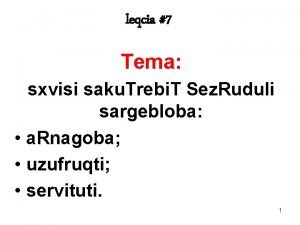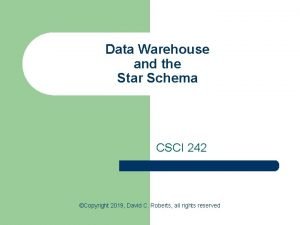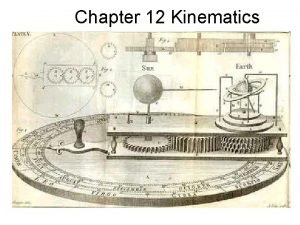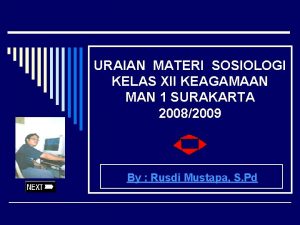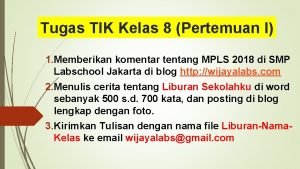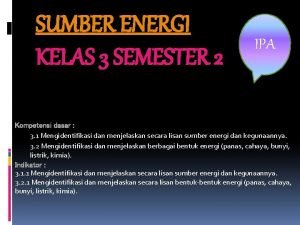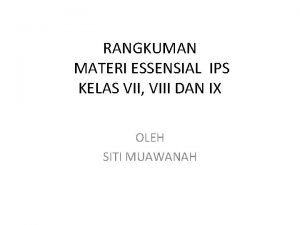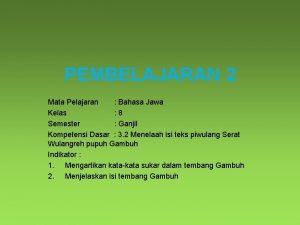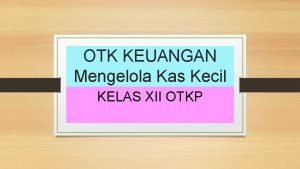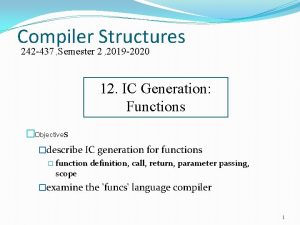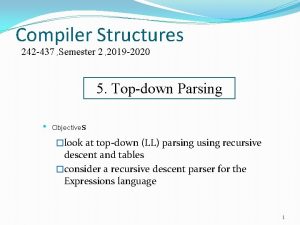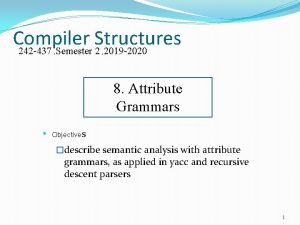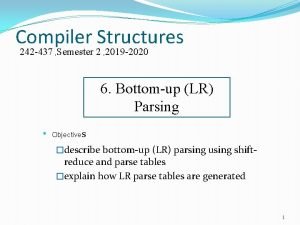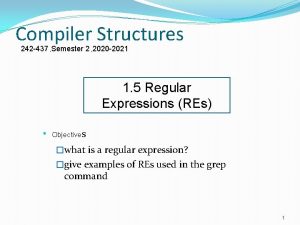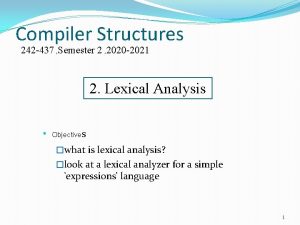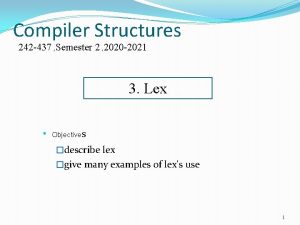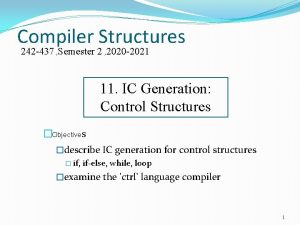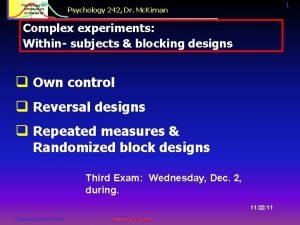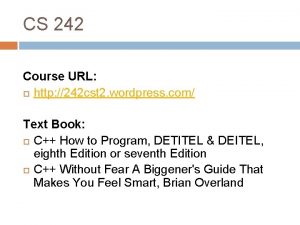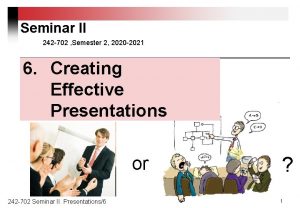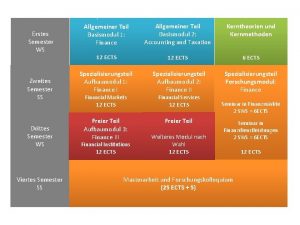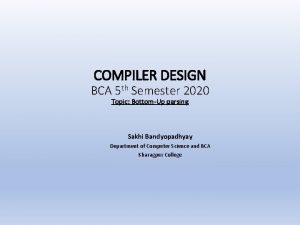Compiler Structures 242 437 Semester 2 2019 2020



![1. The Expressions Grammar • Its LL(1) grammar: Stats => ( [ Stat ] 1. The Expressions Grammar • Its LL(1) grammar: Stats => ( [ Stat ]](https://slidetodoc.com/presentation_image_h/8b80bda0ce79b3ab86f541c460f4a857/image-4.jpg)










![statements() Beforewithand After no semantic actions void statements)void( //statements =: : { ]statement ['n' statements() Beforewithand After no semantic actions void statements)void( //statements =: : { ]statement ['n'](https://slidetodoc.com/presentation_image_h/8b80bda0ce79b3ab86f541c460f4a857/image-15.jpg)






































- Slides: 53

Compiler Structures 242 -437 , Semester 2 , 2019 -2020 9. Creating and Evaluating a Parse Tree • Objective �extend the expressions language compiler to generate a parse tree for the input program, and then evaluate it 1

Overview 1. The Expressions Grammar 2. expr. Parse 2. c 3. Parse Tree Data Structures 4. Revised Parse Functions 5. Tree Building 6. Tree Printing 7. Tree Evaluation 2

Source Program Lexical Analyzer In this lecture Syntax Analyzer Semantic Analyzer Front End Int. Code Generator concentrating on parse tree generation and evaluation Intermediate Code Optimizer Target Code Generator Back End Target Lang. Prog. 3
![1 The Expressions Grammar Its LL1 grammar Stats Stat 1. The Expressions Grammar • Its LL(1) grammar: Stats => ( [ Stat ]](https://slidetodoc.com/presentation_image_h/8b80bda0ce79b3ab86f541c460f4a857/image-4.jpg)
1. The Expressions Grammar • Its LL(1) grammar: Stats => ( [ Stat ] n )* Stat => let ID = Expr | Expr => Term ( (+ | - ) Term )* Term => Fact ( (* | / ) Fact ) * Fact => '(' Expr ')' | Int | Id 4

An Expressions Program (test 3. txt) 5+6 let x 3) ) + //y let x let y =2 x*y/(2 // (comments =5 =x /0 //comments 5

2. expr. Parse 2. c • A recursive descent parser using the expressions language. • This version of the parser differs from expr. Parse 1. c by having the parse functions (e. g. statements(), statement()) create a parse tree as they execute. continued 6

• There's a new print. Tree() function which prints the final tree, and eval. Tree() which evaluates it. • Usage: $ gcc -Wall -o expr. Parse 2. c $. /expr. Parse 2 < test 1. txt 7

Output for test 1. txt > expr. Parse 2 < test 1. txt n n NULL = x 2 printed = tree; y same as + 3 x let x = 2 let y = 3 + x n n NULL = y = x 2 + 3 x continued 8

x being declared x = 2 == 2 y being declared y = 5 == 5 evaluation of the parse tree > 9

3. Parse Tree Data Structures typedef struct Tree. Node { Token oper. Tok; union { char *id; int value; struct {struct Tree. Node *left, *right; } branches; } u; } Tree; A tree is made from Tree. Nodes. 10

Graphically Tree. Node oper. Tok a union, u id one of ID, INT, NEWLINE, ASSIGNOP, PLUSOP, MINUSOP, MULTOP, DIVOP variable name (for ID) OR value OR branches left right integer (for INT) children pointers of this node (used by NEWLINE, ASSIGNOP, PLUSOP, MINUSOP, MULTOP, DIVOP) 11

Macros for Using Tree. Node Fields #define Tree. Oper)t)) (t-(>oper. Tok( #define Tree. ID)t)) (t-(>u. id( #define Tree. Value)t)) (t-(>u. value( #define Tree. Left)t)) (t-(>u. branches. left( #define Tree. Right)t)) (t-(>u. branches. right( 12

4. Revised Parse Functions • The parse functions have the same 'shape' as the ones in expr. Parse 0. c, but now call tree building functions, and return a Tree result. • Functions: �main(), statements(), statement(), expression(), term(), factor() 13

main() Before and After int main(void) { next. Token(); statements(); match(SCANEOF); return 0; } int main(void) // parse, then print and evaluate the resulting tree { Tree *t; next. Token(); t = statements(); match(SCANEOF); print. Tree(t, 0); printf("nn"); eval. Tree(t); return 0; } 14
![statements Beforewithand After no semantic actions void statementsvoid statements statement n statements() Beforewithand After no semantic actions void statements)void( //statements =: : { ]statement ['n'](https://slidetodoc.com/presentation_image_h/8b80bda0ce79b3ab86f541c460f4a857/image-15.jpg)
statements() Beforewithand After no semantic actions void statements)void( //statements =: : { ]statement ['n' } { dprint")Parsing statementsn("; while )curr. Token =!SCANEOF ({ if )curr. Token =!NEWLINE( statement(); match)NEWLINE(; } } //end of statements() 15

Tree *statements)void( { Tree *t, *left, *stat. Tree; left =NULL; dprint")Parsing statementsn("; while )curr. Token =!SCANEOF ({ if )curr. Token =!NEWLINE( stat. Tree =statement(); else stat. Tree =NULL; // error so no tree match)NEWLINE(; if )stat. Tree =!NULL ({ t =make. Tree. Node)NEWLINE, left, stat. Tree(; left =t; } } return left; } //end of statements() 16

Tree Structure for statements • A statements sequence: s 1 n 1 s 2 n 2 s 3 n 3 becomes: n n 3 s 3 n s 2 n NULL s 1 which I'll draw as: n 2 s 2 n 1 NULL s 3 s 1 17

statement() Before and After with no semantic actions void statement(void) // statement : : = ( 'let' ID '=' EXPR ) | EXPR { if (curr. Token == LET) { match(LET); match(ID); match(ASSIGNOP); expression(); } else expression(); } // end of statement() 18

Tree *statement)void( { Tree *t, *id. Tree, *expr. Tree; dprint")Parsing statementn("; if )curr. Token ==LET ({ match)LET(; id. Tree =match. Id(); // build tree node, not symbol table entry match)ASSIGNOP(; expr. Tree =expression(); t =make. Tree. Node)ASSIGNOP, id. Tree, expr. Tree(; } else //expression t =expression(); return t; } //end of statement() 19

Tree Structures for statement = or ID node expr tree 20

expression() Beforewith and After no semantic actions void expression(void) // expression : : = term ( ('+'|'-') term )* { term(); while((curr. Token == PLUSOP) || (curr. Token == MINUSOP)) { match(curr. Token); term(); } } // end of expression() 21

Tree *expression)void( { Tree *t, *left, *right; int is. Add. Op; dprint")Parsing expressionn("; left =term(); while))curr. Token ==PLUSOP(||)curr. Token == MINUSOP (({ is. Add. Op ) =curr. Token ==PLUSOP (? 1 : 0; next. Token(); right =term(); if )is. Add. Op ==1 // (addition t =make. Tree. Node)PLUSOP, left, right(; else //subtraction t =make. Tree. Node)MINUSOP, left, right(; left =t; } return left; } //end of expression() 22

Tree Structure for expression • An expression sequence: t 1 +1 t 2 - t 3 +2 t 4 becomes: +2 t 3 +1 t 4 t 2 23

term() Before and After with no semantic actions void term)void( //term =: : factor ( )'*'|'/' (factor )* { factor(); while))curr. Token ==MULTOP (|| )curr. Token ==DIVOP (({ match)curr. Token(; factor(); } } //end of term() 24

Tree *term)void( { Tree *t, *left, *right; int is. Mult. Op; dprint")Parsing termn("; left =factor(); while))curr. Token ==MULTOP (|| )curr. Token ==DIVOP (( { is. Mult. Op ) =curr. Token ==MULTOP (? 1 : 0; next. Token(); right =factor(); if )is. Mult. Op ==1 // (multiplication t =make. Tree. Node)MULTOP, left, right(; else //division t =make. Tree. Node)DIVOP, left, right(; left =t; } return left; } //end of term() 25

Tree Structure for term • An term sequence: f 1 *1 f 2 / f 3 *2 f 4 becomes: *2 / f 3 *1 f 4 f 2 26

factor() Before and with After no semantic actions void factor)void( //factor =: : ')' expression '(' | INT | ID { if)curr. Token ==LPAREN ({ match)LPAREN(; expression(); match)RPAREN(; } else if)curr. Token ==INT( match)INT(; else if )curr. Token ==ID( match)ID(; else syntax_error)curr. Token(; } //end of factor() 27

Tree *factor)void( { Tree *t =NULL; dprint")Parsing factorn("; if)curr. Token ==LPAREN ({ match)LPAREN(; t =expression(); match)RPAREN(; } else if)curr. Token ==INT ({ t =make. Int. Leaf)curr. Tok. Value(; match)INT(; } else if )curr. Token ==ID( t =match. Id(); //do not access symbol table else syntax_error)curr. Token(; return t; } //end of factor() 28

Match an ID (Extended) Tree *match. Id(void) { Tree *t; if (curr. Token == ID) t = make. IDLeaf(tok. String); match(ID); return t; } // end of match. ID() 29

Tree Structure for factor • There are three possible nodes: tree node or INT node or ID node 30

5. Tree Building Tree. Node • The nodes in a parse tree are connected by the parse functions. • A tree node can have three different shapes: oper. Tok a union id OR value OR branches left right 31

Making a Tree Node Tree *tree. Malloc(void) // a tree node with no fields specified { Tree *t; t = (Tree *) malloc( sizeof(Tree) ); if(t == NULL) { /* out of memory? */ perror("Tree Node not made; out of memory"); exit(1); } return t; } // end of tree. Malloc() 32

Making an ID Node oper. Tok Tree *make. IDLeaf)char *id( { id Tree *t; t =tree. Malloc(); Tree. Oper)t = (ID; Tree. ID)t) = (char (*malloc)strlen)id(+1(; strcpy)Tree. ID)t(, id(; return t; } //end of make. IDLeaf() ID "id str" no symbol table entry created yet 33

Making an INT Node Tree *make. Int. Leaf(int value) { Tree *t; t = tree. Malloc(); Tree. Oper(t) = INT; Tree. Value(t) = value; return t; } // end of make. Int. Leaf() oper. Tok INT value integer 34

Making a Node with Children Tree *make. Tree. Node(Token op, Tree *left, Tree *right) /* Build an internal tree node, which contains an operator and points to two subtrees. */ { Tree *t; t = tree. Malloc(); Tree. Oper(t) = op; oper. Tok op Tree. Left(t) = left; Tree. Right(t) = right; branches return t; left right } // end of make. Tree. Node() 35

6. Tree Printing • The print. Tree() function recurses over the tree, and does three different things depending on the three possible 'shapes' for a tree node. • It includes an indent counter, which is used to print spaces (indents) in front of the node information. 36

void print. Tree)Tree *t, int indent( //print a tree, indenting by indent spaces { print. Indent)indent(; if )t ==NULL ({ printf")NULLn("; return; } : continued 37

Token tok =Tree. Oper)t(; if )tok ==INT( printf%")dn", Tree. Value)t((; else if )tok ==ID( printf%")sn", Tree. ID)t((; else { //operator if )tok ==NEWLINE( printf")\nn("; //show the n else printf%")sn", tok. Syms]tok([; print. Tree)Tree. Left)t(, indent+2(; print. Tree)Tree. Right)t(, indent+2(; } } //end of print. Tree() 38

void print. Indent(int n) { int spaces; for(spaces = 0; spaces != n; spaces++) putchar(' '); } // end of print. Indent() 39

Tree Printing Examples > expr. Parse 2 < test 2. txt * n 5 n / n 67 NULL 3 = x 56 2 = bing_BONG * let x 56 = 2 27 let bing_BONG ) =27 * 2 - (x 56 2 5) * 67 / 3( x 56 40

Graphically n n * n = bing_ BONG = NULL S 1 67 S 3 - 3 x 56 * x 56 / 5 2 27 S 2 2 41

test 3. txt 5+6 let x 3) ) + //y let x let y =2 x*y/(2 // (comments =5 =x /0 //comments 42

> expr. Parse 2 < test 3. txt n n n NULL + 5 6 = x 2 + = = y / 3 / * 2 x y x 5 x 0 43

7. Tree Evaluation • Tree evaluation works in two stages: �eval. Tree() searches over the tree looking for subtrees which start with an operator which is not NEWLINE �these subtrees are evaluated by eval(), using the operators in their nodes 44

Finding non-NEWLINEs n eval. Tree() used here n * n / 5 = 67 bing_ BONG = NULL x 56 * x 56 3 2 27 2 eval() used here 45

Code void eval. Tree)Tree *t( { if )t ==NULL( return; Token tok =Tree. Oper)t(; if )tok ==NEWLINE ({ eval. Tree) Tree. Left)t( (; eval. Tree) Tree. Right)t( (; } else printf% ==")dn", eval)t((; } //end of eval. Tree() 46

int eval)Tree *t( { Symbol. Info *si; if )t ==NULL( return 0; Token tok =Tree. Oper)t(; if )tok ==ID ({ si =get. IDEntry )Tree. ID)t( (; //lookup ID in symbol table return si->value; } : The operator can be one of ID, INT, ASSIGNOP, PLUSOP, MINUSOP, MULTOP, DIVOP 7 possibilities continued 47

else if )tok ==INT( return Tree. Value)t(; else if )tok ==ASSIGNOP ({ //id =expr si =eval. ID)Tree. Left)t((; //add ID to sym. table int result =eval)Tree. Right)t((; si->value =result; printf%")s % =dn", si->id, result(; return result; } else if )tok ==PLUSOP( return eval)Tree. Left)t + ((eval)Tree. Right)t((; else if )tok ==MINUSOP( return eval)Tree. Left)t - ((eval)Tree. Right)t((; : 48

else if )tok ==MULTOP( return eval)Tree. Left)t * ((eval)Tree. Right)t((; else if )tok ==DIVOP ({ int right =eval)Tree. Right)t((; if )right ==0 ({ printf")Error : Div by 0; using 1 insteadn("; return eval)Tree. Left)t((; } else return eval)Tree. Left)t / ((right; } return 0; //shouldn't reach here } //end of eval() 49

Symbol. Info *eval. ID(Tree *t) { char *id = Tree. ID(t); return get. IDEntry(id); // create sym. table entry for id } // end of eval. ID() this function finds or creates a symbol table entry for the id, and return a pointer to the entry (same as in expr. Parse 1. c) 50

Evaluation Examples $. /expr. Parse 2 < test 1. txt : x declared x = 2 == 2 y declared y = 5 == 5 let x = 2 let y = 3 + x 51

$. /expr. Parse 2 < test 2. txt : x 56 declared x 56 = 2 == 2 // test 2. txt example bing_BONG declared bing_BONG = 52 let x 56 = 2 == 52 let bing_BONG = (27 == 110 * 2) - x 56 5 * (67 / 3) 52

5+6 $ /. expr. Parse 2 < test 3. txt let x =2 : 3) ) + x*y/(2 // ==11 x declared //y x =2 let x =5 ==2 let y =x /0 y declared ==3 x =5 ==5 Error : Division by zero; using 1 instead y =5 ==5 (comments 53
 Gezang 437
Gezang 437 Mileszki szkoła
Mileszki szkoła Weerklank 437
Weerklank 437 Yet another compiler compiler
Yet another compiler compiler Cross compiler in compiler design
Cross compiler in compiler design Unsw term dates 2022
Unsw term dates 2022 Muliakan allah bapa
Muliakan allah bapa Gezang 242
Gezang 242 49 cfr part 242
49 cfr part 242 Que eterna gloria vou no ceu
Que eterna gloria vou no ceu He 242
He 242 Carelli kutztown
Carelli kutztown Et 242
Et 242 Algol family
Algol family Manulife strp
Manulife strp Sxvisi svili
Sxvisi svili Step ap 242
Step ap 242 Et 242
Et 242 Schema 242
Schema 242 Hibbeler
Hibbeler I^242
I^242 Is-242.b
Is-242.b Fpunity
Fpunity Homologous structures example
Homologous structures example Programmazione religione scuola infanzia 2019-2020
Programmazione religione scuola infanzia 2019-2020 Informe de gestion educativa
Informe de gestion educativa Interim assessment tea
Interim assessment tea Programa interno de seguridad escolar
Programa interno de seguridad escolar Državna matura 2019/2020
Državna matura 2019/2020 çoçuk kulübü öğretmen ücreti 2019-2020
çoçuk kulübü öğretmen ücreti 2019-2020 Influenza vaccine dosage chart 2019-2020
Influenza vaccine dosage chart 2019-2020 Relazione funzione strumentale area 3
Relazione funzione strumentale area 3 Admission guide 2019-2020
Admission guide 2019-2020 Minimax 2019 2020
Minimax 2019 2020 Materi sosiologi kelas 12 semester 2
Materi sosiologi kelas 12 semester 2 Materi desain grafis kelas 10 semester 2
Materi desain grafis kelas 10 semester 2 U.s. history semester 1 final exam
U.s. history semester 1 final exam Tugas tik kelas 9 semester 2
Tugas tik kelas 9 semester 2 Tugas tik kelas 8 semester 2
Tugas tik kelas 8 semester 2 Chemistry semester 2 review unit 12 thermochemistry
Chemistry semester 2 review unit 12 thermochemistry Kompetensi dasar kelas 3 semester 2
Kompetensi dasar kelas 3 semester 2 Materi ips kelas 6 sd tentang asean
Materi ips kelas 6 sd tentang asean Wharton semester in san francisco
Wharton semester in san francisco English 11 first semester exam
English 11 first semester exam Dramatic irony def
Dramatic irony def Pointing
Pointing Materi segitiga smp kelas 7 semester 2
Materi segitiga smp kelas 7 semester 2 Materi esensial ips kelas 9
Materi esensial ips kelas 9 Ppt prakarya dan kewirausahaan kelas x semester 2
Ppt prakarya dan kewirausahaan kelas x semester 2 Arti modus dalam matematika
Arti modus dalam matematika Materi mice kelas 11 semester 2
Materi mice kelas 11 semester 2 Materi bahasa jawa kelas 8 semester 1
Materi bahasa jawa kelas 8 semester 1 Imprest fund system adalah
Imprest fund system adalah Otk keuangan kelas 11
Otk keuangan kelas 11


